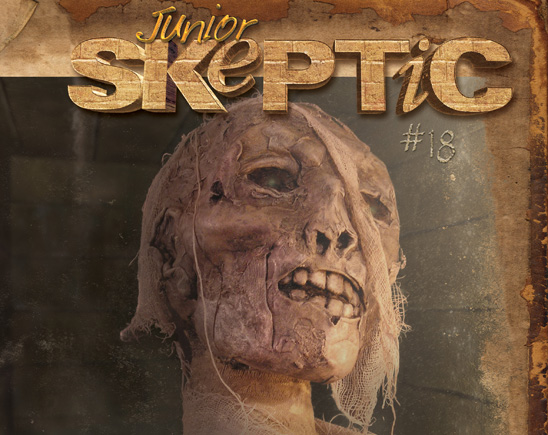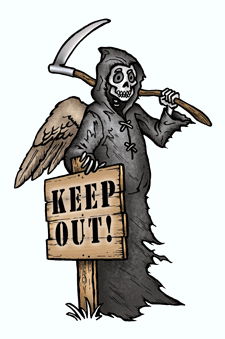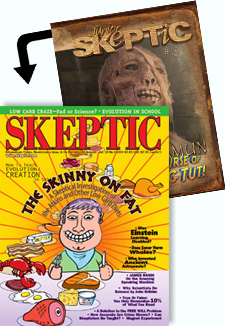In this week’s eSkeptic:
William Lobdell, on Demand
How I Lost My Faith Reporting on Religion in America (and Found Unexpected Peace)
William Lobdell’s journey of faith — and doubt — is one of the most compelling spiritual memoirs of our time. Lobdell became a born-again Christian in his late 20s when personal problems drove him to his knees in prayer. As a newly minted evangelical, Lobdell — a veteran journalist — noticed that religion wasn’t covered well in the mainstream media, and he prayed for the Lord to put him on the religion beat at a major newspaper. In 1998, his prayers were answered when the Los Angeles Times asked him to write about faith. What happened next was a roller-coaster of inspiration, confusion, doubt, and soul-searching as his reporting and experiences slowly chipped away at his faith. While reporting on hundreds of stories, he witnessed a disturbing gap between the tenets of various religions and the behaviors of the faithful and their leaders. He investigated religious institutions that acted less ethically than corrupt Wall Street firms. He found few differences between the morals of Christians and atheists. As this evidence piled up, he started to fear that God didn’t exist. He explored every doubt, every question — until, finally, his faith collapsed. Hear his remarkable story in this lecture based on his new book.
Rent this video for only $3.95 or
Watch the entire series for $49.
INSTRUCTIONS: Click the button above, then click the RENT ONE button on the page that will open in your Internet browser. You will then be asked to login to your Vimeo account (or create a free account). Once you complete your purchase of the video rental, you will then be able to instantly stream the video to your computer, smartphone, or tablet, and watch it for the rental period. Videos play best on Vimeo when you allow the entire video to buffer before viewing it.


MonsterTalk # 83
The Cures of the
Mummy’s Tomb
Unwrap the secrets of the Mummy’s tomb as we talk to “Mr. Mummy” Dr. Bob Brier about the history of mummies and the world’s fascination with Egyptology. And then, we discuss the strange history of mummies as medicine with Dr. Richard Sugg. Join as we learn about The Cures of the Mummy’s Tomb!

Detail of the cover of Junior Skeptic 18 — Tutankhamun and The Curse of King Tut, by Daniel Loxton
About this week’s eSkeptic
“Once Upon a Time, a boy became king.” So began Daniel Loxton’s 2004 story “Tutankhamun and the Curse of King Tut!” for Junior Skeptic 18. That article followed pioneering archaeologist and Egyptologist Howard Carter’s dogged search for Tut’s lost tomb, and asked how the young Pharaoh may have died.
In this week’s eSkeptic, we present the text of the last three pages of the Junior Skeptic 18 on the sinister legend of a lethal supernatural curse associated with Tutankhamun’s tomb. Did the explorers who found the tomb pay for their discovery with their lives?
Junior Skeptic 18 can be found within Skeptic magazine issue 10.4 (2004), available in digital format only as a single back issue on your favourite handheld device, within the Skeptic Magazine App, or on your computer (PC or MAC), via PocketMags.com.
Share this article with friends online.
Subscribe | Donate | Watch Lectures | Shop

by Daniel Loxton
The sense of ancient ritual and mystery surrounding Tut’s tomb quickly inspired rumors that it was protected by supernatural forces. Decades later, those rumors are still with us. According to the legend, an inscription near the tomb’s entrance warned intruders:
“They who enter this sacred tomb shall swift be visited by the wings of death.”
Curses! Fooled Again!
Was there a curse on the tomb? Leaving the issue aside of whether or not curses really work, is it actually true that ancient priests tried to protect the tomb with magic?

Illustration copyright © 2004
by Daniel Loxton.
Considering that the “Curse” has been world-famous for eight decades, it’s really amazing to realize that the answer is “no!” The outer door was sealed with the royal insignia (itself a warning!) but there was no curse inscribed anywhere. (The tomb is still there, of course, and scholars have had almost a century to double-check for an inscription. Nada. Nothing. No curse.)
There are clues that should have tipped everyone off that the curse was only a legend: several versions of the legend feature different made-up inscriptions found in different locations! Some versions claim that the curse was written on the outer door; or on a marker stone near the entrance; or on a piece of treasure inside. Some versions of the curse used the “swift wings” wording, while others claim it said something entirely different!
Where Did the Legend Come From?
No one knows how the Curse legend got started, although it was clearly based on mummy fiction that was popular at the time in Europe. Some claim that Howard Carter, like a Scooby-Doo villain, started the rumors to scare off modern thieves. This is not likely. For security at the tomb, the practical Carter used iron bars, locks, and tough, armed men! In fact, Carter hated the whole “Curse” business, blaming it on “Unpardonable and mendacious statements” by “loose-tongued gossips.” In his Tomb of Tut-ankh-Amen books he wrote that a respectful attitude toward the real accomplishments of ancient Egypt was “entirely opposed to the foolish superstitions which are far too prevalent among emotional people in search of ‘psychic’ excitement.” Carter complained bitterly about “the ridiculous stories which have been invented about the dangers lurking in ambush, as it were, in this tomb, to destroy the intruder. Similar tales have been a common feature of fiction for many years, they are mostly variants of the ordinary ghost story…all sane people should dismiss such inventions with contempt.”
The Canary and the Cobra
Oddly, the first victim of the Curse is rumored to have been a little yellow bird.
The story goes like this:
At the start of his last season of searching for Tut’s tomb, Carter bought a caged canary as a pet (this is true). The workers, with no big finds after seasons of backbreaking labor, hoped that the canary (to them, an exotic “golden bird”) would finally bring them good luck (this might be true). When they then made the most important discovery in the history of Egyptology within a week, this confirmed their view of the “lucky” pet. However, that same day a cobra—the symbol of Egypt and the Pharaoh—crept into Carter’s house and devoured the poor canary. Had the Curse punished the bird for the luck it brought?
There are some problems with this rumor. First of all, it seems that the canary actually lived to a ripe old age after Carter gave it to a female friend!
But the cobra legend is appealing because of its dramatic symbolism—the canary’s magical good luck is devoured by the Curse’s magical power), but it probably isn’t true. Even if it were, that would still only tell us that snakes eat birds, which we knew already. Besides, the legend doesn’t tell us how the cobra unlatched the cage!
Lord Carnarvon’s Death
The Curse became world famous when one of the first people to set foot in the tomb suddenly died. This was great material for the legend: just four months after opening the tomb, Lord Carnarvon was dead.
Carnarvon was born into immense privilege, an English Lord in the last great era of the English aristocracy. He inherited a powerful title, an incredible fortune, and a 36,000 acre estate. At first he was spoiled and irresponsible, as extremely wealthy kids sometimes are, dropping out of one ritzy school after another. As a young man, the only job he ever had was spending money. One writer describes him as appearing “to have been the most superficial of men at a time in history when superficiality was considered by some to be a high calling.”
Although his father had been a scholar and a powerful politician, Carnarvon became one of the “idle rich.” Smart and athletic, he was interested only in amusing himself, playing sports, raising horses, and travel.
Until the accident. While in his 30s, Carnarvon was involved in a catastrophic, near fatal car crash. His body was shattered. He suffered a concussion, temporary blindness, severe burns, a crushed chest, a broken jaw, and dislocated arms. His days as a carefree sportsman were over.
His doctors recommended that he leave cold and rainy England and recover in the hot, dry climate of Egypt. During his stay in Egypt, Carnarvon fell in love with Egyptology.
After a lifetime of accomplishing nothing, he finally found his true passion. When he met Howard Carter, and put his vast fortune behind the quest to find Tutankhamun’s tomb one of the great teams of archeological exploration was formed.
Carnarvon’s death at age 57 was unfortunate, but it was neither paranormal nor unexpected. He’d been in poor health for years. By the time the tomb was discovered, he was a truly sick man—so sick that his teeth were falling out. Any new health problem could have been his last.
What killed him? A mosquito. According to the legend, the insect somehow carried the Curse. Actually, the bite resulted in a minor infection that led to severe complications. Carnarvon died in a hospital three weeks later.
It strikes some people as very mysterious that Carnarvon died of something so minor as a bug bite, but mosquitoes are major killers in hot climates. Mosquitoes can carry all sorts of infections, including malaria and (more recently) West Nile virus. Also, medical science was a lot less advanced in 1923! Penicillin wasn’t even discovered until five years later. Even for a relatively minor infection, there wasn’t much doctors could do.
Although sad, the story does have a silver lining. Carnarvon had lived long enough to set foot inside the greatest discovery in the history of Egyptology—a discovery his wealth, dedication, and hard work had made possible. He was lucky enough to find a dream, and to see it come true!
A Dog’s Life?
When Carnarvon died, according to the legend, the Curse claimed two victims at once. At that very moment, back in England, his dog is supposed to have howled in horror and then dropped dead. This sort of detail enhances the creepiness factor of the Curse legend, but did it really happen?
Apparently not. The story has been kicking around for a long while, but Junior Skeptic wasn’t able to find any reliable basis for this make-believe part of the tale.
There are other problems with the story, too. If you stop to think about it, does it really make sense that the poor dog would suffer because her master had opened a tomb in another, far-off country? Why would Carnarvon’s actions be the dog’s fault? The dog never visited Egypt, never entered the tomb, and had nothing to do with the excavation!
This story also raises the question, how are curses supposed to work, anyway? How would the Curse even find Carnarvon’s dog?
What the Heck Is a Curse?
Whether it’s spoken or written down, a curse is just a word for a mean wish. In stories you can get a lot done by wishing. In real life, just wishing isn’t that effective.
Our ability to imagine the impossible lets us enjoy fiction. We don’t need to constantly interrupt a story by saying, “Hey, that doesn’t make sense!” How exactly does that ring make Frodo invisible? What keeps Aladdin’s carpet up in the air, or turns Cinderella’s pumpkin into a coach? It’s just, well…magic!
In real life, “magic” isn’t a very good answer. The curse legend of Tut’s tomb claims (falsely) that a wish was written there that anyone who went inside would die. We would cheerfully accept this in a horror movie. In real life, though, we have to ask: what exactly is supposed to make such a curse come true? Curses have no body to attack anyone with, and no brain to plot revenge with!
If a treasure was guarded by something more—by Indiana Jones style traps, perhaps—then a curse might have some power! By itself, though, a curse is only a harmless idea.
Just the Facts
There never was a curse on Tut’s tomb—not even a powerless warning. But, let’s imagine that there really was, and that it somehow had the power to kill people. What would this mean?
Well, a lot of people would have been in deep supernatural trouble!
Archeological work is really slow. It took years to find the tomb, and a decade to carefully remove the precious artifacts. During that time, hundreds of workers labored there; armies of photographers, reporters, tourists and guards set up camp; dozens of scientists spent years working in the tomb and with the artifacts; and, many dignitaries (including the Queen of Belgium) were shown inside. Since then, millions of people have visited the tomb or admired the treasure at museums. If there were a curse, an awfully large number of people would have been exposed to it! Surely, a real curse would be completely obvious by now!
Well, we’ve looked, just in case. Investigators have studied the lives of the people who spent the most time with the tomb and artifacts (like guards and major scientists), especially those present at the “big” moments (like the opening of the tomb, or the unwrapping of the mummy). No evidence of those people dying at unusually early ages has ever turned up.
In 1995, magician and paranormal investigator James Randi found that the people most exposed to the Curse lived for an average of 23 years after opening the tomb—on average, to age 73! (See Skeptic Vol. 3, No. 3, pp. 42–43.) Among these, two of the most deeply involved people stand out for “beating the Curse….”
Beating the Curse!
If anyone should have suffered from the Curse, Carter would have been the guy! After all, he found the tomb (while Carnarvon was safe in England), opened it, and spent 10 years working inside it. He was there for every major moment of discovery, including the unwrapping of the mummy. He touched everything, he breathed the ancient air, and he was in charge.

Junior Skeptic 18 is found within Skeptic magazine issue 10.4 (2004), available in digital format only as a single back issue on your favourite handheld device, within the Skeptic Magazine App, or on your computer (PC or MAC), via PocketMags.com.
He was also, apparently, immune to the Curse. If the Curse was supposed to bring death to intruders on “swift wings,” it sure took its time: Carter lived for 16 years after entering the tomb! When he died in England (of natural causes), Carter was 66 years old. No wonder he felt that, “There was perhaps no place in the world freer from risks than the tomb” (which is, after all, an underground bunker in the middle of nowhere)!
Other people at the tomb got off even easier. Many lived well into their 70s and 80s! One Sgt. Richard Adamson (who, Randi writes, guarded the “burial chamber day & night for seven years”) lived no less than 57 years after the tomb was opened!
Anthrax?
Some writers have suggested that the “Curse” could be real—if the tomb was contaminated! Anthrax spores, for example, really could have lain dormant in the tomb until Carter’s men entered and disturbed the ancient dust inside.
There are two problems with this suggestion. First, the air was tested at the time. Carter wrote that, “When it was opened, scientific research proved it to be sterile.” Of course, Carter could’ve been wrong. Tests were less reliable in those days….
But, the fact remains that the tomb wasn’t really dangerous! Carnarvon was already sick when he arrived at the tomb, and no one else caught anything. It’s an intriguing idea, but it “explains” a mystery that never really existed!
The Bottom Line
In 2002, a study by Dr. Mark Nelson in the British Medical Journal confirmed James Randi’s evaluation of the Curse. Like Randi, Nelson found that exposure to the tomb had no effect on longevity.
Although this formal and high profile debunking of the “Curse” got international publicity, the legend continues to lurch onward…a bit like the undead, actually! ![]()












